Al Nahir Shines
By Ghada Al Slik, Professor at Baghdad University.
July 2020
Al Nahir Street Story
Al Nahir Street (meaning River Street) is the first modern street that was opened in the traditional urban fabric of Baghdad city; it was the Ottoman governor Nadhum Pasha who ordered the opening of the street in 1910.
The starting point of the street was Al Mustansiryia School, with its prime location on the banks of the Tigris River, which was used as a customs house during this period. Despite its age and long history it was in good condition. Al Mutansiriya School was built in 1250 as a university by Caliph Al Mustansir at the end of the Abbasid period.
Goods were brought to Baghdad by boats from Basra city in the south and Mosul city in the north of Iraq, and were stored in the Al Mustansirya School building. From there the goods were transported to the near by Khans (wholesale markets). This route of goods prompted the start of the Al Nahir street even before its official establishment.
The street continued south, reaching the British Lynch Company, which was the main commercial transportation company working the sea route from Basra city on the gulf to India.
The street was just wide enough for the passing of trolleys and small wagons carrying a variety of merchandise such as wood, dates and grains to the many Khans (wholesale markets) including: Pasha Khan – Al Tamr Khan – Adlia Khan – Dafterdar Khan – Dallah Khan – Al Khudhairi Khan – Al Namla Khan – Al Nabka Khan.
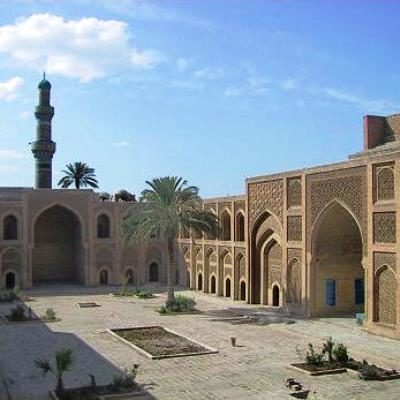
Al Mustansiriya School

Location of Al Mustansiriya School on the banks of Tigris River

Al Mustansirya School, View from Tigris River
Al Nahir Street Naming:
Al Nahir Street first named Kumrik Street (customs), and then it took the name of Khafafeen Street after an old suq (market) with a similar name. It has also been called Sa’achia, after a watch selling market in the area. The name Al Nahir Street prevailed as it was parallel to the river Tigris, even after the name of the street was officially changed to Al Mustansir Street by the Mayoralty of Baghdad in 1930, in honor of the Abbasid Caliph Al Mustansir.
Since its establishment and even now, the street extends from Al Mustansiriya School to the intersection with Al Ahrar Bridge is officially called Al Mustansir Street, while the name Al Nahir Street is used by the public.
The Growth of the Silver and Gold Shops in Al Nahir Street:
Since its beginning, silversmith shops were located in Al Nahir Street. In the 1920’s, the street was not paved and water sellers “sakka “used to fill their leather bottles with water from the river and dampen the sand surface twice a day. The silversmith shops in the area used to pay for that work.
There was a public bath called Haider Bath, used after work by the silversmiths and goldsmiths. It is located almost in the middle of Al Nahir Street where the Chamber of Commerce building is located today. At present the Haider Bath is abandoned and is in poor condition, although a sug with same name is still in existence.
The silver and gold shops were always located in two different and separated areas in the street. The growth and flourish of these shops in Al Nahir Street went through many developments and changes in intervals of about 10 year.
1920’s Period: The Beginning and Growth of Silver Shops
This period is known for the beginning of growth in silver shops and the opening of several new shops in Al Nahir Street. This came as a result of the immigration of several well-known silversmiths from Amara, a town in southern Iraq, to Baghdad, and who established their businesses in Al Nahir Street, near Al Ahrar Bridge.
Among these silversmiths were: Amara, Baghal and Abbas, (together in one shop ) – Joda Sahar and Jani Sahar, Sadood, Naass, Looti Athab, Sakran, Khamas, Sabti, (together in one shop) – Dail Abdul Hassan and his brother Ghalib – Ghareeb and Saeed Dakheel – Nashoor Ghanim , and his brother Thiab – Salih Hajim and his brother Shatti, – Dhamin Huwazawi, – Khabit , Yasir Sigar and his brother Nasir, – Aanis Faiadh, – Khuadhair Al Khamisi. – Raheem Barghooth.(*)
1930’s Period: Growth of Gold Shops
The 1930’s saw increase in the number of gold shops in Al Nahir Street and the growing popularity of an immigrant goldsmith from Baku Russia in Al Nahir Street and his positive influence on the trade in general.
The Russian goldsmith Vladimir Sigal, had his son Tola working with him and an Armenian engraver called Arshawel. (*)
The first gold shop was opened in the 1930’s. It had four goldsmiths in one shop they were : Salih Aish. – Abdulrazak Saif. – Khalf Jabir. – Naji Hermiz. In the late 1930’s other gold shops were opened, by Ghadeer Bajoor, – Ibrahim Waham and Najm Abdullh.(*)
1940 Period: Silversmiths Expanded their Work to Include Gold
The growth continued into the 1940’s by the opening of new gold shops, this was characterized by the expansion of some of the Subba (mandian) from their usual trade working in silver to now include gold.
This occurred after the revolution of Rashid Ali Al Gailni in 1941. Several Subba who were the majority of silversmiths, left Baghdad for Amara for about 40 days. When some returned to Baghdad they started working in gold..Those were Shiekh Anizi, – Salih Hajim, – Yasir Sikar, – Salim Shahib, (*)
In 1945 another important addition to the gold shops was Khalil Malallah, who acquired the shop of Sabti’s (*), This shop flourished as a gold and mina shop, and continued to be popular for a long time.
In 1946 Abbas Amara opened his own gold shop. He iwas the father of the Iraqi poet Lami’a Abbas Amara, and the brother of the well-known silversmith Zahroon Amara, who established his shop in the 1920’s.
1950’s Period: More Growth of Gold Shops, and the Jewish Community Sell its Jewellery to Al Nahir Street Shops.
The gold shops continued to grow in number, but however during the period from 1948 to 1950’s, many Iraqi Jews left Iraq selling, their inventory to the shops in Al Nahir Street.
1960’s -1970’s Period: Flourish and Growth, Relocation of Major Goldsmiths to Al Nahir Street from Other Regions in Iraq and from Baghdad.
Another political event that led to the growth of the gold shops in Al Nahir Street was the Shawaf revolution in Mosul city at the start of the 1960″s. After the violent consequences of the revolution, a large number of Christians left Mosul city to settle in Baghdad. The goldsmiths among them opened shops in Al Nahir Street.
At the same time, some of the gold shops of Khadhumyia gold suq opened branches in Al Nahir Street, such as Hashim Al Ward and others.
Al Nahir Street grew in the 1960’s and 1970’s as a gold and silver market, and also became known for women’s clothing and shoe shops. As shops opened gradually, the street gained the name of Banat (girls) street, as young women were seen as the main shoppers in the area!
1980’s Period: The Last Growth and Shine Period
In the 1980’s the area was rehabilitated, turned to pedestrian –only, with new pavement and some street furniture installed.This period was the last of the shining periods; after that many events influenced the street and the gold and silver business to decline.
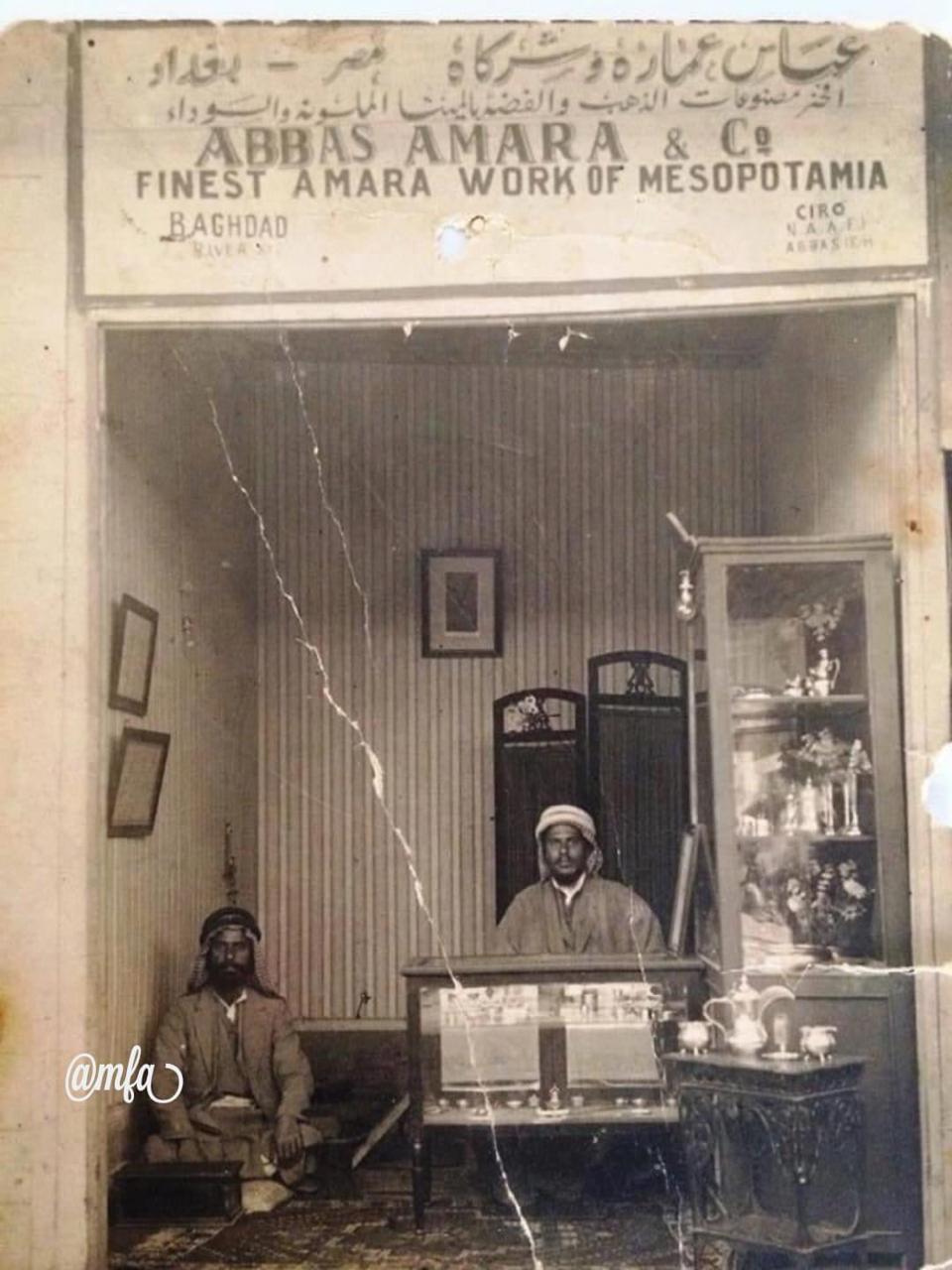
Amara Shop, Al Nahir Street
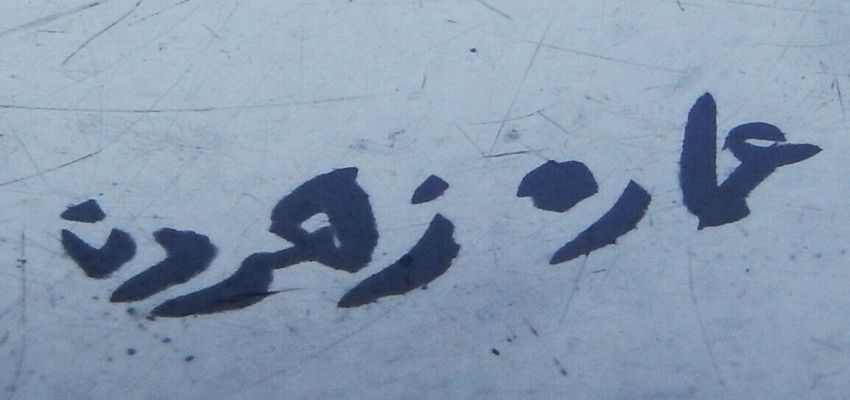
Zahrroon Amara Signature on Silver Pieces
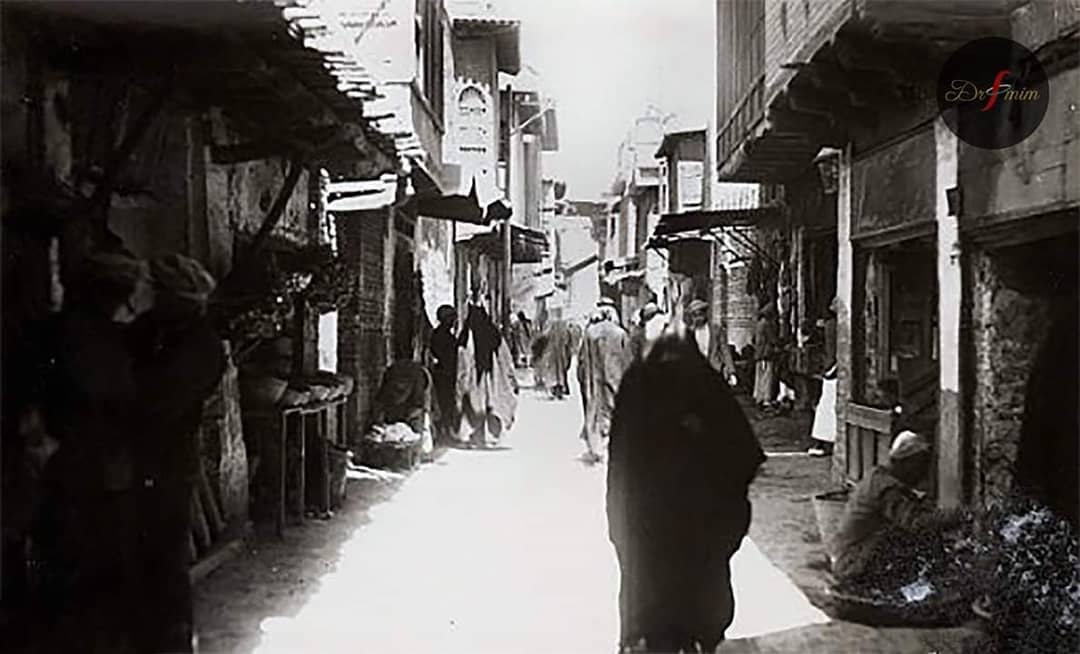
Al Nahir Street
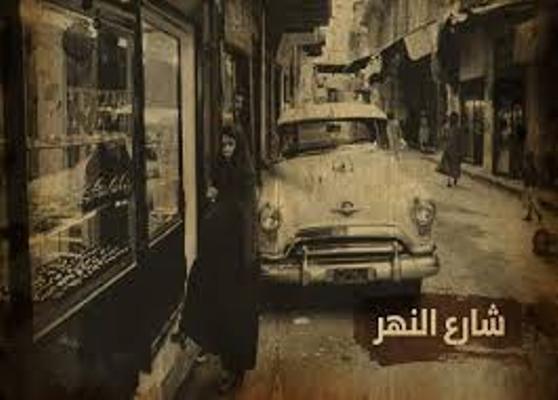
Al Nahir Street 1950's
The Decline of Silver and Gold Shops in Al Nahir Street
Two main suburbs became popular in Baghdad in the 1950’s and 1960’s. They were Karada and Mansour which their growth had begun in the 1930’s. These suburbs had their own suqs which attracted goldsmith from Al Nahir Street, first as branches of the main shops in al Nahir Street. Eventually many owners closed their shops in Al Nahir Street, keeping only the suburban shops open.
The commercial center of the old city of Baghdad began to slow down when a new law for commercial streets was created in 1986, allowing commercial spines in the suburban districts, and in the inner city.
The traditional Rashid Street, the main street parallel to Al Nahir Street, saw land use change as those new commercial spines attracted individual shops and trades. Al Nahir Street gradually turned to wholesale trade, with fewer people shopping for their daily needs.
During the sanctions on Iraq in the 1990’s two variables affected the jewellery market; the first is that people were seeking essential needs, and considered jewellery a luxury; secondly was the migration of goldsmiths from Iraq to other countries. Subsequently the Al Nahir Street jewellery shops decreased from around 1000 combined gold and silver shops to only 109 gold shops and 20 silver shops in 2011. Gold and silver shops made up 47% of the total number of shops in Al Nahir Street. while clothing and shoe shops were 46%. The remaining buildings were mosques, shrines, and banks.(**)
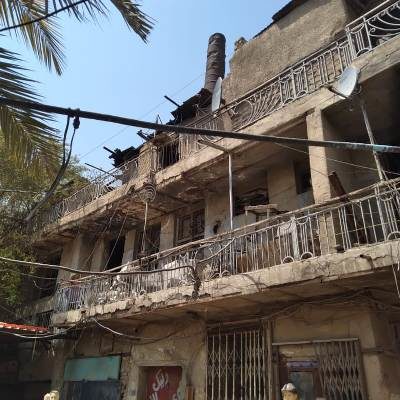
Haider Bath, Al Nahir Street, Image Municipality of Rusafa
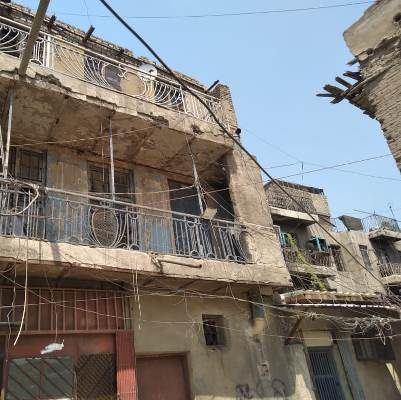
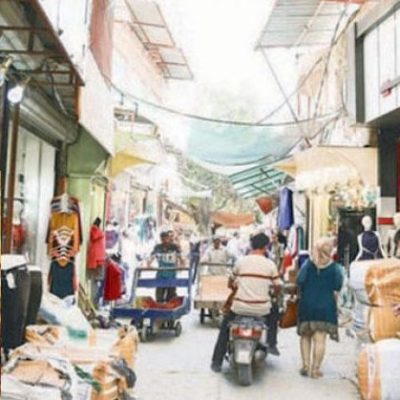
Al Nahir Street 2000's, Image Rafal Ibrahim
Heritage Buildings in Al Nahir Street
Al Nahir Street is the oldest modern street in the old city of Baghdad, but heritage buildings are only 34% of the total. New buildings were constructed as older ones deteriorated; intensive urban renewal took place, and infill projects displayed modern designs with no clear character or taste.
The remaining traditional buildings currentlyare all near Al Mutansirya School, according to information from the Municipality of Rusafa the list includes (***):
- Qablania Suq( coveredsuq )
- Men’s Abaya Suq (men’s cloak clothing)
- Drapery Suq
- Khaldia Takia (religious sufi building)
- Khafafeen Mosque
- Kudhari Mosque
- Pachachi Mosque
- Shrine of Kalbini
- Shrine of Shaikh Samri
- Shrine of Ismael Muharib
Although Al Nahir Street lost its former character as the main gold and clothes suq in Baghdad , it still has its reputation for being the gold and silver suq. There are plans for the rehabilitation of Rashid Street area, the traditional buildings and the gold suq.
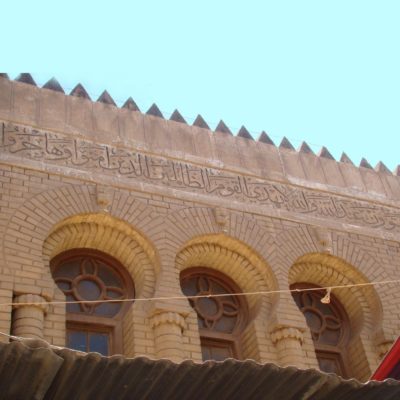
Adilia Mosque Al Nahir Street , Image Amna Basim 2015
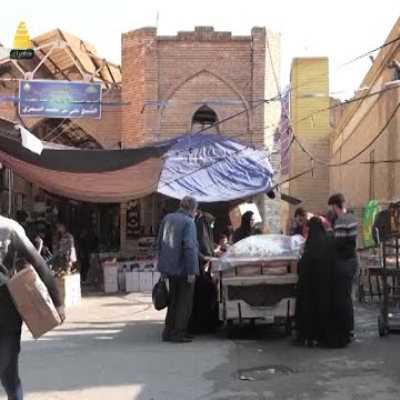
Covered Suq Entrance, right Al Mustansiriya School

Traditional house used as clothing Shop, Al Nahir Street. Image Amna Basim, 2015
Front Image:
Location Map Al Nahir Street between Al Ahrar and Al Suhadaa Bridge , Image Russafa Municipality
Sources:
*Tawfiq Baghal, Baghdad Memories, Al Mada, 2019
**Rafal Ibrahim, Al Nahir Street in Baghdad a Study in the Functional Structure, College of ArtsJournal, Baghdad University, Journal# 99.
*** Municipality of Rusafa
Images that are not attributed have been sourced from the internet and are of unknown origin.
————————————————————————————————————————————————————————————————————————————————————————-
About Ghada Al Slik:
Ghada Al Silk is a Professor, and a previous head of Department of Architecture, College of Engineering, University of Baghdad. Ghada specializes in the field of theory and conservation of architecture. Author of the book (City of Stories), founder of Docomomo Iraq 2016, chair of Iraq Docomomo International, and member of the Higher Committee of the Basic Design of Baghdad City, Mayoralty of Baghdad and consultant 2008-2018. Recipient of the Excellence Award, (Tamayous) Iraqi women architects, 2013.Founder Member of the Makyia foundation for the development of Baghdad, 2015.Editorial member of The Iraqi Journal of Architecture, since 2000, Journal of Iraqi Engineers Society, and other academic and professional committees.

